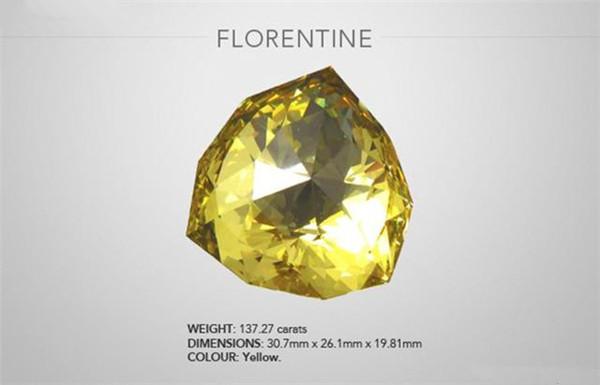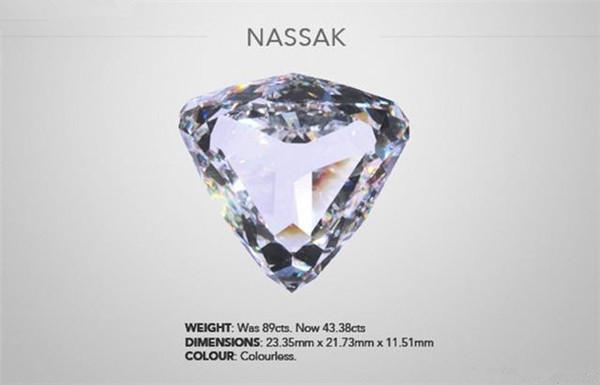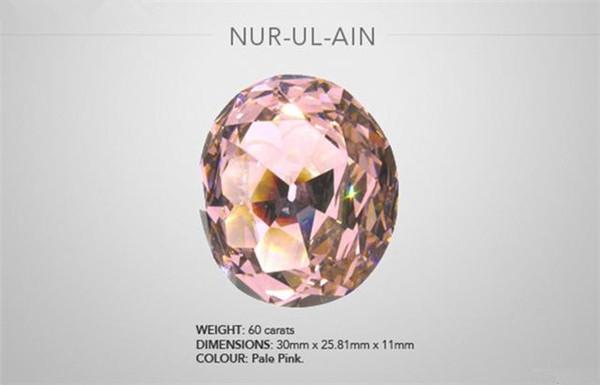Showfay Jewelry | How many of the world's ten most famous diamonds do you recognize?
Have you ever heard of the ten most famous diamonds in the world, but now it is difficult to see them again, because these diamonds are either privately collected by collectors or have been re cut. However, with existing data preservation and scientific technology, we can view the past ghosts of these precious and rare diamonds through 10 replicas.
1 BAZU Diamond

BAZU Diamond, whereabouts unknown
BAZU is a 32.62 carat colorless diamond and the largest regular hexagonal cut diamond. In about 1749, it was inlaid on the gold wool medal made for King Louis XV of France, and was decorated with 107.88 carat Brittany spinel, three large yellow topaz, several 5 carat diamonds and hundreds of 0.1 carat diamonds. At that time, it was considered the most expensive luxury item among all European luxury goods. In September 1792, the Golden Fleece Medal was stolen along with many French jewelry crowns. The diamond suffered significant damage and was later re embedded with the Hope Diamond. Brittany's spinel was also recovered years later, but all other stones have disappeared into the mist of history.
2 BLACK ORLOV Black Orlov Diamonds

Legend has it that the 67.50 carat pillow cut Black Orlov black diamond originated from the private collection of Russian princess Nadiavykin Orlov in the mid-18th century. Unfortunately, this origin is incorrect as there is no literature on this Russian princess, so its origin remains a mystery to this day.
Today, Black Orlov is owned by New York gemstone dealer Charles F. Winson, who pocketed it for a high price of $150000 in the early 1950s.
3 CULLINAN Cullinan Diamonds

Cullinan Diamond No. 1, discovered in South Africa and existing in the British Royal Family
Cullinan weighs 3106 carats and is the largest gemstone grade diamond ever discovered. Discovered in 1905 by Frederick Wells, the director of the prolific senior mines in South Africa. Eighteen feet below the Earth's surface, Wells noticed a shiny object on a steep wall several feet high, which was the initial scale of Cullinan. This massive original has undergone multiple design modifications to create 9 unparalleled diamonds, among which the famous Cullinan I Cullinan 1 diamond is also known as the African Star, weighing 530.20 carats and was once the world's largest polished diamond.
4 DRESDEN GREEN Green

Green Dresden is a 40.70 carat green diamond, whose source is almost unknown. However, in 1722, a news article in London stated that Mr. Marcus Moses from India was honored to wait to admire King George I's large diamond, which was an emerald green diamond, and His Majesty was very happy about it.
This diamond is named after Dresden, the capital of Saxony in Germany, and is a unique green diamond among the world's famous diamonds. The original stone may be elongated and unbroken, as green diamonds rarely split. GIA has determined its cleanliness level to be VS1. Surprisingly, its symmetry is good, and its polishing is extremely exquisite. It is rare to have produced such exquisite diamonds before 1741. The green color of a diamond is due to its radioactive substance.
5 FLORENTINE

The Florentine diamond was once a yellow diamond belonging to the Medici family. This ancient Indian diamond is actually light yellow with a light green hue and a very irregular shape. It is a double-sided rose cut diamond, weighing 137.27 carats.
The discovery of diamonds in legend can be traced back to 1467, when around 1625 Thomas Cletscher divided the originally rough diamonds into 170 carats and 120 carats. Later, it was further cut into a water droplet shape by Tavernier, with a total of 144 sections. Shortly after World War I, the Florentine diamond was stolen in 1918 and its whereabouts are still unknown.
6 HOPE Hope Blue Diamond

Many people believe that Hope Blue Diamond is the world's largest blue diamond, but this is not the case. It is actually the fourth largest, but it cannot be denied that it is the world's largest dark blue diamond. The original weight of this 45.52 carat Hope Blue Diamond is 112 carats. French diamond dealer Jean Baptiste Tavernier once obtained this stone from slaves and sold it to King Louis XIV. He then cut it into a triangular pear shaped stone weighing 67.5 carats. After the death of Louis XIV, this blue diamond disappeared. Until 1830, a large blue diamond of different shapes and weights appeared in the British market, held by banker Henry Thomas Hope.
7 NASSAK

The Nassak diamond was originally a triangular diamond of about 90 carats, which was re cut into a triangular diamond of about 78 carats, but the rounded corners were more pronounced. This still does not conform to the taste of historical changes. Later, it was re cut into a 43 carat rectangle. The name Diamond comes from the town of Nassak, a famous pilgrimage site located 95 miles northeast of Mumbai. It attracts thousands of believers every year and still has some famous temples to this day. After several changes, in 1940, Hairy Winston bought it and cut it into its current flawless 43.38 carats. In the 1940s, Mrs. Leeds of New York purchased this diamond and set it on a ring. It was later successfully auctioned off in New York in 1970 and is now being collected by private buyers.
8 PASHA

PASHA was once considered the best diamond in the Egyptian treasury, weighing 40 carats and cut in a bright octagonal shape. Unfortunately, the whereabouts of the gemstones are currently unknown. Later, Barbara Hutton purchased diamonds from King Farouk of Egypt in the 1920s and cut them back into a 36 carat diamond.
9 TIFFANY YELLOW

Tiffany yellow diamond is a beautiful canary yellow diamond, rumored to have been discovered in 1877 in the origin of the De Beers or Kimberley mines in South Africa. The gemstones were first transported to Paris, and after a year of research by experts, they were designed and cut by the outstanding gemologist George F. Kunz in 1878, resulting in the birth of a 128.54 carat pillow shaped diamond. The 90 facets make the diamond shine more brightly, shining like a raging fire. It is worth mentioning that Tiffany yellow diamonds have an unusual feature of maintaining their color through artificial light. The designers decided to ignore modern proportion rules as they would result in a significantly lower than 100 carat borehole. Tiffany&Co, the head of Tiffany's Paris office, purchased Tiffany Yellow for the company for $18000 and shipped it to the United States in 1879.

Nur ul ain is an approximately 60 carat oval diamond, whose name means "light" in Persian and Arabic. Discovered in Gorkanda, India around 17, it is one of the largest diamonds of its pink type.
Along with the larger Darya i-noor diamond, it is considered one of the two most famous gemstones in the Iranian crown. Nur ul ain is a delicate crown made in 1958 for the wedding of Queen Farah and Iran's last Mohammad Reza Shah Balevi, consisting of 324 diamonds.
- Company Info
- Feedback
- Customer Reviews
- About Us
- Dropshipping
- FAQ
- User Center
- Forget Password
- My Orders
- Tracking Order
- My Account
- Register
- Payment & Shipping
- Terms And Conditions
- Return Policy
- Shipping Methods
- Payment Methods
- Discount
